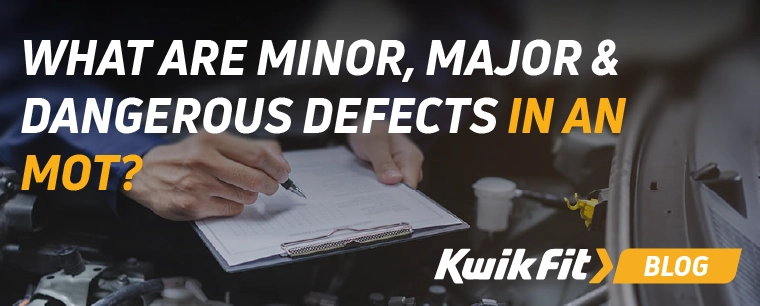What Are Minor, Major & Dangerous Defects In An MOT?
Jessica Bird | Saturday 26th July 2025 9:35am

Back in 2018, the UK saw major changes to the MOT test system, which updated the way faults and problems on a vehicle are classified. Since then, all vehicle faults on Class 3, 4, 5, and 7 vehicles are recorded as either Minor, Major, or Dangerous rather than the simple pass, fail, or advisory system used before this.
But why was the MOT criteria changed? How do the defect categories work? And what constitutes a dangerous defect? Well, letís answer those and a few other questions here.
Minor MOT faults
A Ďminorí fault would be considered one where the problem does not cause an immediate safety risk, but should be rectified soon. This is very similar to the previous system, whereby an advisory is given to items that the driver should be aware of and may cause a future MOT failure if not addressed. An MOT certificate will still be issued if a vehicle only has minor faults.
Example:
All vehicles manufactured since 1971 must have a minimum of 2 brake lights (or stop lights) at the rear of the vehicle. If a vehicle has three brakes lights and one is not functioning, the vehicle will receive a Minor defect on the MOT check.
Major MOT faults
A Ďmajorí fault is more serious. It includes elements that pose a potential safety risk to drivers and other road users, but it can also be a defect that has a damaging impact on the environment. These faults will result in an MOT failure during testing, and the owner will not be issued with an MOT pass certificate until the issues have been rectified.
Example:
Using the same vehicle as in our first example, if two of the three brake lights are inoperative (specifically, more than Ĺ), the vehicle will receive a Major defect on the MOT.
Dangerous MOT faults
Finally, a fault classed as Ďdangerousí is one that poses an immediate risk to the safety of the driver and other road users. As such, if a vehicle has a dangerous fault then it should not be driven until the fault, or all listed dangerous faults, have been rectified. This will also result in an immediate MOT failure.
Example:
Letís take our vehicle with a brake light problem once again. If all of the brake lights are missing, broken or inoperative, the vehicle will receive a Dangerous defect on the MOT check since other road users will have no way of telling if the vehicle is braking or coming to a stop.
Why is MOT testing important?
MOT testing isnít a Ďnice to haveí - itís a legal requirement that helps keep everyone on the road safe. In the UK, most vehicles must pass an MOT test every year to ensure they meet key safety and environmental standards. There are some exceptions, such as if a car is under three years old, but itís worth making absolutely certain that your car is exempt before you forgo testing. If youíre unsure, refer to MOT exemption guidelines.
Without a valid MOT certificate, itís illegal to drive your car (unless youíre on your way to a pre-booked test), and doing so can land you with a fine, points on your licence, and may even invalidate your insurance. Find out more about driving without an MOT.
While they are a legal requirement, MOT tests do more than keep you on the right side of the law. They help catch issues you might not be able to spot, allowing you to get ahead of any repairs and giving you confidence that your vehicle is safe to drive.
From worn-out tyres and faulty bulbs to brake problems, an MOT can highlight faults before they become dangerous or expensive to fix. Keeping up with your MOT gives you peace of mind that your vehicle is roadworthy and performing as it should. So, while the annual test might feel like a chore, itís an essential part of responsible car ownership, helping to protect you, your passengers, and all other road users.

Get ahead with pre-MOT checks at home
Before heading to your MOT, itís a good idea to check a few simple things that could help your car pass first time (or at least avoid a preventable failure). From lights and tyres to windscreen wipers and fluid levels, some quick DIY checks can make all the difference, and theyíre all simple to do in 10 minutes outside your home or place of work.
If youíre not sure where to start, Kwik Fit has a handy MOT pre-checks guide that walks you through the basics, helping you feel more confident and potentially avoiding a retest.
MOT testing with Kwik Fit
With over 600 centres, our experienced technicians across the country provide the local communities with quality MOT testing they can rely on.
Book in for an MOT test at your local Kwik Fit centre, or give us a call. Our teams are always happy to help with any queries and advise you on the particulars of your MOT results, from discussing the dangerous defects you need to act on now to planning ahead to resolve any minor advisories.
Any facts, figures and prices shown in our blog articles are correct at time of publication.
Featured Articles
Is it Illegal to Drive With One Headlight?
Saturday 19th July 2025
Wondering if itís illegal to drive with one headlight? Learn about the safety risks and penalties of illegal blown bulbs and why you should fix them promptly.
Air Con in EVs & Hybrids: Experts Answer Your Questions
Monday 30th June 2025
Does air con drain EV batteries? Can you use the air con while charging an electric car? Find out the answers to these questions & more from Kwik Fitís experts.
Why Is Your Car Making a Noise? Fixes & Tips
Friday 13th June 2025
When your car starts making unexpected noises, it can certainly be quite disconcerting; it may be nothing to worry about, but hereís what you need to know.









